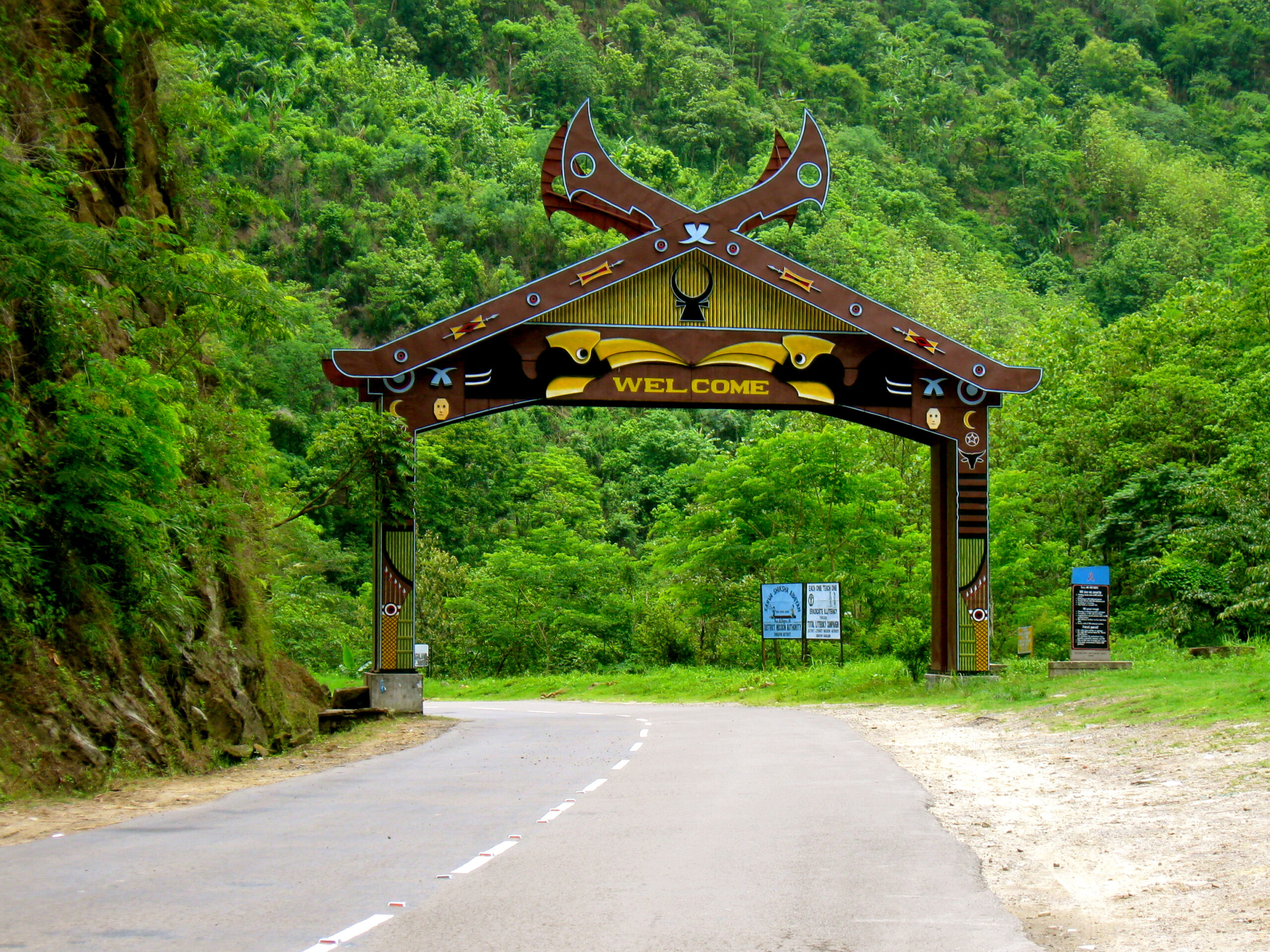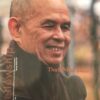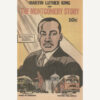 Entrance to Nagaland
Entrance to Nagaland
In a recent book on peacebuilding, Thania Paffenholz sets out functions that Non-governmental Organizations can carry out in situations of violent conflict: protection, monitoring, advocacy, public communication, in-group socialization, social cohesion, intermediation, facilitation, and service delivery. (1) In practice some of these functions overlap, or more than one can be carried out at the same time by the same organization. Nevertheless a function-analytical framework can be useful for a choice of activities and for building awareness of the ways different functions interact among each other. Thus it would be useful to analyse different experiences of peacebuilding done by IFOR and FOR and see what lessons can be learned. For an example of the monitoring of a cease-fire agreement and facilitating communication among parties it is useful to look at IFOR and the Nagaland Peace Mission.
The International Fellowship of Reconciliation’s active interest in the fate of Asia’s tribal societies began in 1964, when the Nagaland Peace Mission, led by IFOR members Jayaprakash Narayan (former Indian Congress leader and Sarvodaya worker) (2) Rev. Michael Scott (later IFOR’s UN representative in New York (3) and B.P. Chaliha (then Chief Minister of Assam, the Indian state in which Nagaland was found prior to the 1965 creation of new states in northeast India) was born.
The Nagaland Peace Mission was a decade-long effort to maintain a cease-fire agreement between the Indian government and the underground Naga rebels who wanted to create an independent country. In fact, the Nagas claimed that they were already independent — Nagaland declared independence one day before India did in 1947.
The Nagas began a freedom struggle in 1951 using the Gandhian tactics of civil disobedience. Led by Angami Zapu Phizo, tribal people refused to sell food and other supplies to the Indian military and police. Teachers and children withdrew from schools and village headmen resigned their jobs. Angami Phizo had earlier been willing to use violence since he had fought the English with the Japanese-backed Indian National Army of Subhash Chandra Bose in 1944. However, he became convinced of the effectiveness of the non-violent techniques of Mahatma Gandhi and for five years the Naga struggle for independence was largely based on Gandhian methods.
The non-violent protests came to an end in 1956 when a Naga army was created. The Japanese advance into India from Burma during World War II was stopped in Nagaland and many weapons were left over. Weapons were later received from China and Pakistan. Consequently, the Indian military moved into Nagaland. Repeated accusations of human rights violations were made against the Indian army.
There are some one and a half million Nagas, evenly divided between India and Burma., now Myamar. Some 90 percent of the Nagas are Baptist Christians (although traditional religious ideas about the soul and contact with the ancestors continue) — the result of a century of American Baptist missionary work. The joke was that there was a higher percentage of Baptists in Nagaland than in Mississippi. “Nagaland for Christ” was the battle cry of the Naga insurgency.
In order to weaken the Naga Baptist leadership and to eliminate independent observers, the Indian government expelled all Baptist missionaries in 1955. The missionaries were blamed for abetting “a foreign conspiracy to separate the Naga Hills from India and retain it as an imperialist stronghold.” India has persistent fears of foreign manipulation behind all moves for secession or greater autonomy, as can be seen today concerning Kashmir and Punjab.
Such fears are not groundless. In northeast India, the fears were reinforced by the 1962 Chinese attack which reached the Assam foothills. As the Nagas and most other northeastern tribal societies are of Mongol stock and speak Tibeto-Burmese languages, the Indian government fears a ‘Pan-Mongol’ movement under Chinese influence. The Indian government has encouraged (or not prevented) Indians from other areas to settle in the northeast. This has been especially true for the Bengalis, who started coming in the 1930s, and has now escalated into a larger, illegal migration of Bengalis from Bangladesh looking for land and economic opportunities. Nagas and other tribal people feel that they are becoming minorities in their own land.
Tensions over the administrative divisions of India have existed since Independence and had grown to be an important national issue by 1964. Thus there was an effort to reorganize India into states according to linguistic lines. Northeast India which had been only the state of Assam was divided into Assam, Nagaland, Meghalaya, Manipur, Tripura, Mizoram and Arunachai Pradesh. The Indian government hoped that by creating linguistically-based states, local aspirations could be linked to the wider structures and goals of a national government.
The creation of a Nagaland state within the Indian federation divided Naga opinion. Some leaders were willing to go along with the new structure. Other leaders, including Phizo, considered the new Nagaland government an Indian puppet and continued working for a totally independent country.
The Nagaland Peace Mission members had been concerned about the tensions for some time. In 1958, Rev. Scott, who had contacts with the Indian government because of his support for Indian civil liberties in South Africa, had discussed the Nagaland question with Indian leaders. Gandhians in India were increasingly concerned by the violence. By 1964, enough contacts had been made between underground armed leaders, Baptist Church authorities, and Indian government leaders to propose and have a cease-fire accepted.
Much of the Peace Mission’s work consisted of Peace Observers teams, which included Gandhian peaceworkers such as Marjorie Sykes, a long-time close worker with Mahatma Gandhi and military representatives from each side. The Peace Observers’ job was to investigate complaints from either party about cease-fire violations. They also tried to promote a peaceful atmosphere. At the same time, work was undertaken to deal with the root causes of the tensions: poverty, ethnic-cultural differences and too little local political power. (4).
J.P. Narayan played a role as an active mediator, but stressed the Indian Congress position that Nagaland needed to remain within the Indian federal unioin; “Within the broad limits of the Union of India” he said “it is possible to negotiate any special kind of relationship”. Just prior to Indian Independence, Prime Minister Nehru had told Naga leader Phizo that “We can give you complete autonomy but never independence. You can never hope to be independent. We will use all our influence and power to suppress such tendencies.”
By early 1996, Indira Gandhi became the Indian Prime Minister and began centralizing the government. In May 1966 Rev. Scott was deported from India and all his papers seized. The Nagaland Peace Mission came to a formal end, although peace work was carried on by Gandhian Indians and Baptist Church authorities under the name of the Naga Peace Council.
After 1966, the Indian government followed a two-track policy. One track was to stress autonomous institutions and development; the other track was to increase the activities of the Indian army and the police. Thus, Nagaland has democratic institutions with an elected state legislature and representatives in the Indian Parliament in New Delhi. Large sums of development funds come from the central government which has led to the creation of an urban middle class which sees benefits in remaining part of India. A 2005 study by the United Nations stressed the great strides in education, health and income — all of which are higher than the overall Indian average. At the same time, there was a heavy Indian army presence in Nagaland. Under the Armed Forces Special Powers Act, the army was allowed to arrest on suspicion and without a warrant and to shoot to kill.
With Nagaland under close control of the Indian army, the armed Naga resistance moved across the frontier to the Naga area of Burma from where it would make cross-border raids into India while also fighting the Burmese government. In Burma, the Naga resistance movement took the name of the National Socialist Council of Nagaland —Isak-Muival after the name of its two leaders Isak Swu and Thuingaleng Muival. The Burma-based insurgency was too weak to modify the structures of Nagaland, but they were able to create a climate of insecurity. There was also a steady flow of small arms coming through Burma to Nagaland and from there to other armed movements in northeast India. In addition there was a flow of narcotics coming from the ‘Golden Triangle’ of Burma to Nagaland and then to other parts of India and abroad. Always on the trails of narcotics flows, one finds violence as criminal gangs try to control the flow or to get a “cut of the business”.
The situation was largely stalemated for nearly two decades of 1970s and 1980s, and there were no fruitful contacts between the Naga insurgency and the Indian authorities. In 1996, I was asked if I would sponsor a representative of the Naga insurgency to come to Geneva to lobby at the United Nations as I had already done with the Burmese national minorities and representatives of the Chittagong Hill Tracts of Bangladesh which also had an armed insurgency.
Such sponsorship poses at least three issues. One is to request a visa from the Swiss government on their behalf. I am a US citizen and the headquarters of the Association of World Citizens is in California so one must ‘play fair’ with the Swiss authorities.
A second issue is working with armed insurgencies while not justifying the use of armed violence. My position has always been that the insurgency did not ask my advice before starting. Thus my role is to see if there are some possibilities for a peaceful settlement.
The third issue is that I do not have any real control over the person coming and especially over other contacts that he may make while in Geneva. These are battle-hardened individuals who are used to dealing in life-and-death situations. Geneva has always been a city for arms deals although the arms are not located in Geneva. It is also a city where many political meetings are held in the shadows among people who can not be seen meeting elsewhere.
Thus in 1996, the leader of the National Socialist Council of Nagaland was with me for a week of meetings during the UN Commission on Human Rights. I helped set up meetings with Asian government diplomats and with NGO representatives. I tried to create a meeting between the Deputy Representative of India and the Naga leader. The Indian government representative, whom I knew fairly well, explained that just a few days before the Naga insurgency had killed three policemen and that he could not meet with a person who ordered the killing of the police. I said that I understood his position and added however in my conversations with him, I had the impression that some sort of an agreement might be reached. It was just a feeling; I was passing on no specific offer.
Other behind-the-scene negotiations must have gone on because less than a year later in 1997, there was a meeting in Zurich between the leader who had been with me and the Indian Ambassador. A cease-fire was negotiated which has been renewed periodically since.
All has not become calm in Nagaland. There have been deep divisions among the Naga on tribal lines, and there have been fratricidal ‘turf wars’ along with extortion as ‘taxes’ to different armed groups. The arms have been less used, but they have not been collected either. There remains a constant flow of arms through Nagaland coming from China through Burma and Bangladesh. The narcotics flow has lessened as Afghanistan has largely replaced the ‘Golden Triangle’ as the home of opium production, but narcotics-based violence still continues.
There has been created a Naga Reconciliation Forum of local community groups. Some international mediation work would still be needed to strengthen the Forum. It would be useful for some FOR members to check with US Baptist groups to see if any contacts have been re-established and if anything useful can be done by those outside to help in the reconciliation process in Nagaland.
The Nagaland Peace Mission is a good example of non-violent monitoring and can be cited as a precedent when other such opportunities arise. It is also an example of the need to be able to field teams of experienced people over a long period of time and of the dangers of the banning of foreign members of such a team.
Notes
- Thania Paffenholz (Ed).Civil Society and Peacebuilding (Boulder, CO: Lynne Rienner, 2010, 511pp.)
- For a good portrait of Jayaprakesh Narayan (1902-1979) see Bimal Prasad Gandhi, Nehru and J.P.: Studies in Leadership (Delhi: Chanakya Publications, 1985, 294pp.)
- For a moving account of his work in South Africa see Michael Scott A Time to Speak (London: Faber and Faber, 1958, 365pp.)
- For a short description of the Nagaland Peace Mission see the article by a chief actor M. Aram “Peace in Nagaland” in A. Paul Hare and Herbert H. Blumberg (Eds.) Liberation without Violence: A Third Party Approach (London: Rex Collings, 1977, 368pp.)







